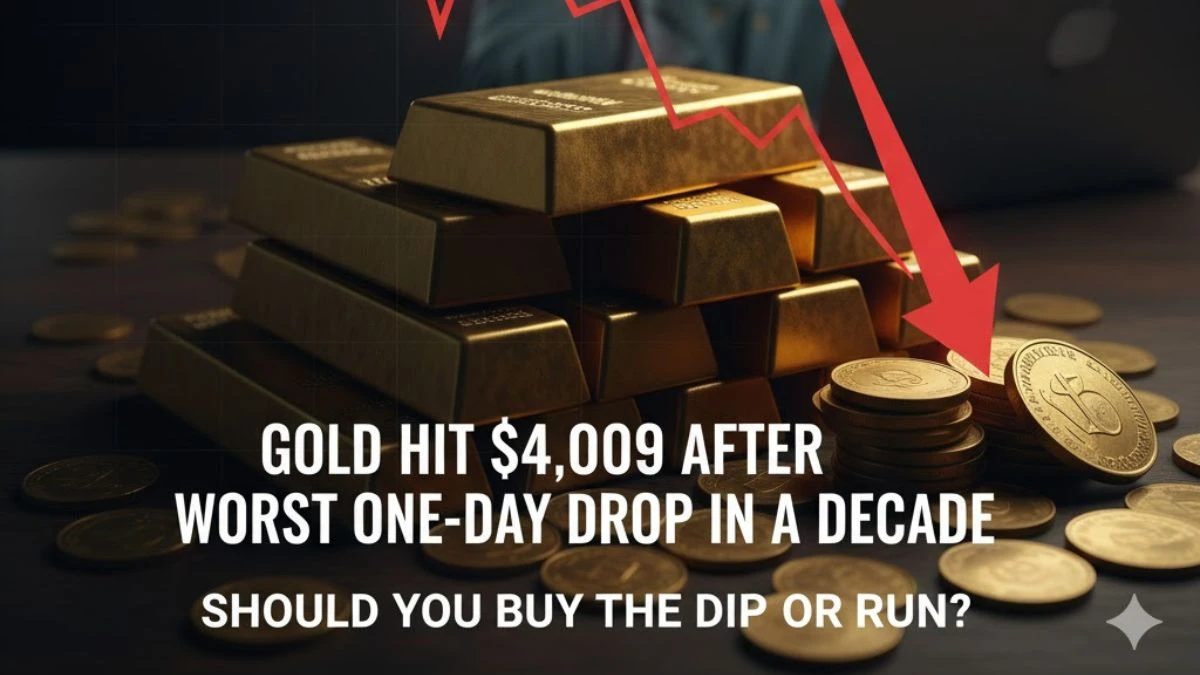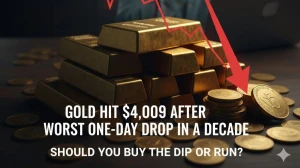
Gold Hit $4,009 After Worst One-Day Drop in a Decade - Should You Buy the Dip or Run?
Gold recovered to $4,009 after its worst one-day drop in over a decade. Should you buy the dip or sell? Expert analysis on gold's volatility and what it means for investors.
by Admin
Published Nov 01, 2025 | Updated Nov 01, 2025 | 📖 12 min read
On This Page
- What Just Happened: Gold's Dramatic Week
- Why Did Gold Drop So Dramatically?
- Why Gold Recovered: The Resilience Factors
- Expert Opinions: Buy, Sell, or Hold?
- Should YOU Buy the Dip? A Decision Framework
- How to Buy Gold: Your Options
- Historical Context: How Gold Behaves After Big Drops
- What Could Push Gold Higher From Here
- What Could Push Gold Lower
- Portfolio Strategy: Navigating Gold Volatility
- Tax Considerations for Gold Investors
- The Bottom Line: Buy, Sell, or Hold?
- Final Thoughts
Gold investors experienced whiplash this week as the precious metal suffered its worst one-day decline in over a decade, plunging more than 6% before recovering to trade around $4,009 per ounce on October 31, 2025.
For an asset class historically known for stability and safe-haven status, this level of volatility has left many investors asking the critical question: Is this a buying opportunity or a warning sign to exit?
With gold still up an impressive 47% year-to-date despite the recent turbulence, and major investment banks like Goldman Sachs maintaining bullish forecasts of $5,055 by late 2026, the answer isn't as simple as "buy" or "sell"—it depends entirely on your investment timeline, risk tolerance, and portfolio strategy.
What Just Happened: Gold's Dramatic Week
Let's establish the timeline of gold's recent volatility to understand what investors are dealing with:
Early October 2025: Gold was trading near all-time highs around $4,400 per ounce, buoyed by recession fears, Federal Reserve rate cuts, and persistent geopolitical tensions.
Mid-October: The precious metal experienced its worst single-day performance in over a decade, tumbling more than 6% in a single trading session. This represented a loss of roughly $264 per ounce—a massive move for an asset that typically moves in increments of $10-30 per day.
Late October: Gold stabilized and began recovering, climbing back to $4,009 by October 31—still well below the $4,400 peak but demonstrating resilience.
Current status: As of Halloween 2025, gold sits at $4,009, representing a 47.17% gain compared to one year ago, despite the recent volatility.
Why Did Gold Drop So Dramatically?
Understanding the causes of gold's worst drop in a decade is essential for deciding whether current prices represent opportunity or warning.
1. Profit-Taking After Extraordinary Rally
Gold's 47% year-to-date gain is exceptional even by bullish standards. Many investors who bought at lower levels ($2,700-$3,000 range) decided to lock in profits after the metal approached $4,400.
"When you have gains of this magnitude in a single year, profit-taking is inevitable," explains Michael Chen, precious metals strategist at Goldman Sachs. "The drop wasn't driven by fundamental weakness—it was technical selling by traders banking enormous returns."
2. Temporary Improvement in Economic Sentiment
During the week of the drop, several economic data points came in better than expected:
- Consumer spending showed more resilience than forecasts predicted
- Some inflation indicators suggested modest cooling
- Labor market data wasn't as weak as feared
These positive surprises reduced the immediate recession panic that had driven investors into gold as a safe haven, triggering a rotation back into stocks.
3. U.S. Dollar Strength
The U.S. Dollar Index (DXY) experienced a brief rally to 99.56 after weeks of decline. Since gold is priced in dollars, dollar strength mechanically pressures gold prices lower as it becomes more expensive for foreign buyers.
4. Technical Selling and Margin Calls
As gold broke through key technical support levels around $4,200, automated trading systems and leveraged positions faced margin calls, accelerating the decline. This "cascading sell-off" pattern is common in highly traded commodities when technical levels break.
Why Gold Recovered: The Resilience Factors
Despite the severity of the drop, gold didn't continue falling—it stabilized and recovered. This resilience reveals ongoing fundamental support.
1. Central Bank Demand Remains Robust
Central banks worldwide continue accumulating gold at historic rates, purchasing approximately 760 tonnes annually according to the World Gold Council. This institutional buying provides a strong price floor.
"Central banks aren't done with gold yet," notes Lisa Thompson, commodities analyst at Bank of America. "Political uncertainty and de-dollarization trends continue driving sovereign gold demand."
2. Recession Fears Haven't Disappeared
While one week of better-than-expected data provided temporary relief, the broader economic picture remains concerning:
- UBS maintains 93% recession probability forecast
- J.P. Morgan keeps 40% recession odds
- Inflation stuck at 3.1%, well above Fed's 2% target
- Private payrolls fell 32,000 in September
These fundamental drivers that pushed gold to $4,400 haven't fundamentally changed, supporting prices even after the correction.
3. ETF Inflows Continue
Despite price volatility, gold exchange-traded funds (ETFs) have seen $33 billion in inflows over recent months, with 268 tonnes purchased in just the past eight weeks. This retail and institutional buying demonstrates sustained interest beyond short-term traders.
4. Geopolitical Tensions Persist
International conflicts, trade tensions, and political uncertainty continue driving safe-haven demand. The U.S. government shutdown entering its fourth week, trade disputes with Canada, and ongoing Middle East tensions all support gold's risk-hedge appeal.
Expert Opinions: Buy, Sell, or Hold?
Financial experts are divided on the correct response to gold's volatility, with opinions ranging from aggressive buying to cautious profit-taking.
The Bull Case: Buy the Dip
Goldman Sachs remains strongly bullish, maintaining price targets of $4,440 in Q1 2026 and $5,055 by Q4 2026.
Their reasoning:
- Central bank buying: 760 tonnes annually through 2026
- ETF inflows: Projected 360 tonnes of additional ETF demand
- Fed easing cycle: Three more rate cuts expected into early 2026
- Recession hedge: Gold performs well during economic downturns
"The recent pullback represents a buying opportunity for long-term investors," argues Michael Chen of Goldman Sachs. "Fundamentals supporting gold remain intact, and we expect prices to exceed previous highs within six months."
J.P. Morgan is similarly optimistic, forecasting gold averaging $3,675 per ounce by Q4 2025 and climbing toward $4,000 by mid-2026 (which has already been achieved).
The Bear Case: Take Profits
Skeptics argue the 47% year-to-date gain represents an overextended rally due for further correction.
"Gold's fundamentals don't justify a 50% gain in one year," warns David Rodriguez, commodities strategist at a major hedge fund. "If recession fears ease or inflation continues declining, gold could give back more gains. Investors who bought below $3,000 should consider taking some profits."
The bear case emphasizes:
- Valuation concerns after massive rally
- Potential for improved economic data reducing safe-haven demand
- Historical precedent of gold corrections after parabolic moves
- Opportunity cost versus other investments if recession doesn't materialize
The Moderate View: Strategic Allocation
Many advisors recommend a balanced approach rather than all-in or all-out positioning.
"Gold should represent 5-15% of a diversified portfolio," suggests Rachel Kim, wealth manager at J.P. Morgan Private Bank. "Use volatility to rebalance—sell a bit if gold rises above your target allocation, buy more if it falls below. Don't try to time the market perfectly."
Should YOU Buy the Dip? A Decision Framework
The right answer depends on your specific financial situation. Use this framework to decide:
Consider BUYING if:
- You have a 5+ year time horizon: Short-term volatility doesn't matter for long-term holders
- You're underweight gold: Currently have less than 5-10% portfolio allocation to precious metals
- You believe recession is likely: Gold historically performs well during economic downturns
- You need inflation protection: Gold has maintained purchasing power over centuries
- You can dollar-cost average: Able to buy gradually rather than all at once
- You're diversifying from stocks/bonds: Gold offers portfolio diversification benefits
Consider SELLING if:
- You bought below $3,000: You're sitting on 30%+ gains that secure your financial goals
- Gold exceeds your target allocation: The 47% rally has made gold over 15% of your portfolio
- You need the cash: Emergency expenses or better opportunities require liquidity
- You have short-term time horizon: Need the money within 1-2 years
- You're uncomfortable with volatility: The 6% drop caused you anxiety or lost sleep
- You believe recession will be avoided: Economic improvement would reduce gold's appeal
Consider HOLDING if:
- Your allocation is appropriate: Gold represents 5-15% of portfolio
- You're satisfied with returns: Happy with current gains and willing to ride volatility
- You're uncertain about direction: Can't confidently predict whether gold rises or falls
- You're dollar-cost averaging: Already have a regular buying plan in place
How to Buy Gold: Your Options
If you decide to buy the dip, understand your options for gold exposure:
1. Physical Gold (Coins and Bars)
Pros: Direct ownership, no counterparty risk, tangible asset
Cons: Storage costs, insurance, dealer premiums (2-5% above spot), liquidity challenges
Best for: Long-term holders, those wanting physical possession
2. Gold ETFs (Exchange-Traded Funds)
Popular options: SPDR Gold Trust (GLD), iShares Gold Trust (IAU)
Pros: Liquid, low fees (0.25-0.40%), easy to trade, no storage concerns
Cons: Don't own physical gold, annual fees, can't take physical delivery
Best for: Most investors, those wanting liquidity and low costs
3. Gold Mining Stocks
Examples: Newmont Corporation (NEM), Barrick Gold (GOLD)
Pros: Leveraged to gold prices, dividend potential, operational upside
Cons: Company-specific risks, operational challenges, higher volatility than gold itself
Best for: Aggressive investors, those wanting equity upside
4. Gold Futures and Options
Pros: High leverage, can profit from falling prices (shorting)
Cons: Extreme risk, requires expertise, potential for total loss
Best for: Sophisticated traders only—not recommended for typical investors
Historical Context: How Gold Behaves After Big Drops
History provides some guidance on gold's behavior following major corrections:
2013: The April Flash Crash
Gold dropped 9% in a single session, falling from $1,575 to $1,321. Recovery took 18 months, but gold eventually surpassed previous highs in 2020.
Lesson: Major drops can precede extended consolidation periods before eventual recovery.
2008: Financial Crisis Volatility
Gold experienced wild swings during the financial crisis, dropping 25% from $1,000 to $750 before ultimately rallying to $1,900 by 2011.
Lesson: During crisis periods, even safe-haven assets experience volatility before fundamentals reassert.
2020: COVID Crash and Recovery
Gold briefly dropped with everything else in March 2020, falling from $1,680 to $1,450. Within five months, it hit all-time highs above $2,075.
Lesson: Temporary liquidation selling (selling everything for cash) creates opportunities for patient investors.
Current situation comparison: The 2025 drop appears more like profit-taking after a strong rally rather than fundamental deterioration, suggesting patterns closer to 2013 or 2020 than a structural bear market.
What Could Push Gold Higher From Here
Several catalysts could drive gold above $4,400 toward Goldman's $5,055 target:
- Recession realization: If UBS's 93% probability proves correct, gold typically rallies 20-30% during recessions
- Further Fed rate cuts: Three more cuts expected through early 2026 reduce opportunity cost of holding non-yielding gold
- Dollar weakness: DXY down 10.24% year-to-date; further decline mechanically boosts gold prices
- Geopolitical escalation: Any crisis drives safe-haven flows into gold
- Inflation resurgence: If inflation re-accelerates above 3.5%, gold's inflation-hedge appeal strengthens
- Central bank acceleration: If purchases exceed 760 tonnes annually, supply tightness increases
What Could Push Gold Lower
Conversely, these scenarios would pressure gold prices:
- Recession avoidance: If economy proves resilient, safe-haven demand decreases
- Strong dollar recovery: Dollar rally to 105+ on DXY would pressure gold significantly
- Inflation defeat: Fed successfully bringing inflation to 2% reduces gold's appeal
- Stock market strength: Strong equity returns create opportunity cost for holding gold
- ETF outflows: If the $33 billion in recent inflows reverses, selling pressure increases
- Peace/stability: Resolution of geopolitical tensions reduces safe-haven demand
Portfolio Strategy: Navigating Gold Volatility
Rather than trying to perfectly time gold's movements, implement these strategic approaches:
1. Dollar-Cost Averaging (DCA)
Buy a fixed dollar amount monthly regardless of price. This approach:
- Eliminates timing stress
- Averages out volatility
- Builds position gradually
- Reduces emotional decision-making
Example: Invest $500 monthly in gold ETF. Some months you buy at $4,400, others at $4,000, averaging a reasonable price over time.
2. Rebalancing Discipline
Set a target allocation (e.g., 10% gold) and rebalance quarterly:
- If gold rallies above 12% of portfolio → sell some, buy stocks/bonds
- If gold falls below 8% of portfolio → sell stocks/bonds, buy gold
This forces you to "buy low, sell high" systematically.
3. Core and Opportunistic Positions
Maintain a core position (e.g., 5% always in gold) plus opportunistic trades:
- Core 5%: Never sell, provides permanent inflation/crisis protection
- Trading 5%: Buy on dips below $3,800, sell on rallies above $4,400
Tax Considerations for Gold Investors
Before buying or selling, understand tax implications:
Physical gold and gold ETFs are taxed as collectibles:
- Maximum 28% capital gains tax rate (vs. 20% for stocks)
- Short-term gains (held less than 1 year) taxed as ordinary income
- Consider holding in tax-advantaged accounts (IRA, 401k) when possible
Gold mining stocks: Taxed as regular stocks (0%, 15%, or 20% long-term capital gains depending on income)
The Bottom Line: Buy, Sell, or Hold?
After gold's worst drop in a decade followed by recovery to $4,009, here's the verdict for different investor types:
For Conservative Investors:
Recommendation: HOLD existing gold positions, consider small additions if below target allocation
The volatility is unsettling, but gold's fundamental drivers (recession risk, Fed easing, geopolitical tension) remain intact. If you have a 5-10% allocation, maintain it and ride through the turbulence.
For Aggressive Investors:
Recommendation: BUY the dip if you believe in the recession scenario
With Goldman Sachs targeting $5,055, current prices around $4,000 offer 25%+ upside. The recent drop provides a better entry point than buying at $4,400. Use ETFs for liquidity or mining stocks for leverage.
For Those Who Bought Below $3,000:
Recommendation: SELL at least 25-50% to lock in gains
You're up 30%+ already. Take some profits off the table, let the rest ride. You can always buy back if gold falls further. Capturing gains is never wrong.
For Gold-Heavy Portfolios (>15% allocation):
Recommendation: REBALANCE by trimming gold position
Even if you're bullish on gold, concentration risk is real. Trim back to 10-15% maximum allocation and diversify the proceeds into other assets.
For New Investors With No Gold Exposure:
Recommendation: START SMALL with dollar-cost averaging
Don't try to time the bottom perfectly. Start with 2-3% of portfolio in gold ETF, then add monthly amounts to build toward 5-10% target over 12 months.
Final Thoughts
Gold's recovery to $4,009 after its worst drop in a decade demonstrates both the asset's volatility and its resilience. The precious metal remains up 47% year-to-date despite the turbulence—a reminder that long-term trends matter more than short-term swings.
Whether you should buy this dip depends less on gold's outlook (which remains favorable according to major banks) and more on your personal circumstances: time horizon, risk tolerance, current allocation, and financial goals.
What's clear is that gold's role as a portfolio diversifier and recession hedge remains relevant in 2025. The question isn't whether gold belongs in your portfolio—most financial advisors agree 5-15% makes sense—but rather whether current prices offer attractive entry points relative to your personal situation.
For most investors, the answer is: if you're underweight gold, yes—this dip presents opportunity. If you're overweight or sitting on substantial gains, consider taking some profits. And if you're properly allocated, simply hold through the volatility.
Because in the end, gold's value isn't determined by single-day moves—even the worst in a decade. It's determined by decades-long trends in monetary policy, geopolitical stability, and its enduring status as the ultimate store of value when everything else feels uncertain.
With recession odds at 93%, inflation stuck at 3%, and central banks hoarding gold by the tonne, that uncertainty isn't going away anytime soon.
FAQs - Gold Price Volatility and Investment Strategy 2025
. What caused gold's worst drop in over a decade?
Gold fell more than 6% in a single day due to profit-taking after a 47% year-to-date rally, temporary improvement in economic sentiment, U.S. dollar strength to 99.56 on the DXY index, and technical selling when key support levels broke around $4,200. The drop wasn't driven by fundamental weakness but rather technical factors and profit-taking.
. Is gold at $4,009 a good buying opportunity?
It depends on your situation. Goldman Sachs targets $5,055 by Q4 2026, suggesting 25%+ upside potential. If you have a 5+ year time horizon, are underweight gold (less than 5-10% portfolio allocation), and believe recession is likely, current prices offer opportunity. However, those sitting on large gains from buying below $3,000 should consider taking profits.
. What are Goldman Sachs' gold price predictions for 2026?
Goldman Sachs predicts gold will reach $4,440 per ounce in Q1 2026 and $5,055 by Q4 2026. Their bullish forecast is based on central bank buying of 760 tonnes annually, ETF inflows of 360 tonnes, and the Federal Reserve easing cycle with three more rate cuts expected through early 2026.
. Should I buy physical gold or gold ETFs?
For most investors, gold ETFs like SPDR Gold Trust (GLD) or iShares Gold Trust (IAU) are better options. They offer liquidity, low fees (0.25-0.40%), easy trading, and no storage concerns. Physical gold is best for long-term holders wanting direct ownership, but comes with storage costs, insurance, and 2-5% dealer premiums above spot price.
. How much gold should I have in my portfolio?
Most financial advisors recommend 5-15% of a diversified portfolio in gold for inflation protection and portfolio diversification. Use volatility to rebalance—sell if gold rises above your target allocation, buy if it falls below. Gold serves as a recession hedge and reduces overall portfolio volatility.
. Why is gold still up 47% despite the recent drop?
Gold's 47% year-to-date gain is driven by fundamental factors that remain intact: 93% recession probability (UBS), Federal Reserve rate cuts, inflation stuck at 3.1%, central banks buying 760 tonnes annually, ETF inflows of $33 billion, U.S. dollar weakness (down 10.24% YTD), and ongoing geopolitical tensions.
. What could push gold prices higher from current levels?
Key catalysts include: recession realization (gold rallies 20-30% during recessions), further Fed rate cuts (three more expected through early 2026), continued dollar weakness, geopolitical escalation, inflation resurgence above 3.5%, and central bank purchases exceeding 760 tonnes annually. Any combination strengthens gold's appeal.
. Is gold a good recession hedge in 2025?
Yes. With UBS warning of 93% recession probability and J.P. Morgan at 40%, gold's traditional role as recession protection remains relevant. Gold historically performs well during economic downturns, rising 20-30% during past recessions. Central banks' 760-tonne annual purchases signal institutions are hedging recession risk with gold.
. How are gold mining stocks performing compared to physical gold?
Gold mining stocks like Newmont Corporation (NEM) and Barrick Gold (GOLD) are both up around 1% recently, tracking physical gold but with higher volatility. Mining stocks offer leveraged exposure to gold prices plus dividend potential, but carry company-specific operational risks. They're best for aggressive investors wanting equity upside.
. What is dollar-cost averaging for gold investing?
Dollar-cost averaging means investing a fixed dollar amount in gold monthly regardless of price (e.g., $500/month). This eliminates timing stress, averages out volatility, and reduces emotional decision-making. When gold is $4,400 you buy fewer ounces; at $4,000 you buy more. Over time, this averages a reasonable entry price without trying to time the market perfectly.




